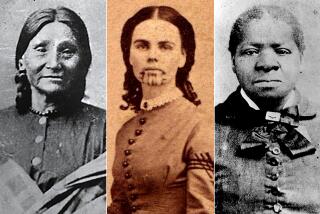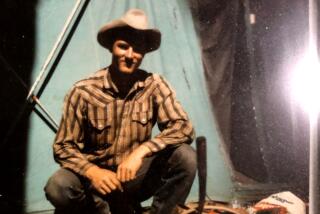Fictionalized View of an Adventurer
- Share via
Bridger: The Story of a Mountain Man by David Kherdian (Greenwillow: $11.75; 146 pages)
In 1822 Jim Bridger, an 18-year-old blacksmith with a thirst for adventure and a determination to see the mountains of the West, signed on with an expedition led by Gen. William Ashley “to ascend the river Missouri to its source.” Author David Kherdian allows the young adventurer to speak for himself in “Bridger: The Story of a Mountain Man,” beginning with his voyage up debris-laden “Old Muddy” and ending two years later with his discovery of the Great Salt Lake. The story also traces Bridger’s transformation from untested greenhorn to seasoned trapper and pioneer.
The real James Bridger was part of a loose fraternity who called themselves mountain men, hardy loners who roamed the Rocky Mountains in the early part of the 19th Century. Like all of these men, he studied the ways of the Indians, the masters of wilderness survival, and learned from them.
The fictionalized Jim Bridger is a keen and eloquent observer of nature, of the men he “floated (his) stick with” and the Indians he encountered, of the beaver he sought for their highly prized fur. (When hats made of beaver fur went out of fashion in the late 1830s, the price of pelts plummeted, and trapping was no longer profitable.)
Bothersome Lapses
Bridger’s voice is thoughtful and clear, but there are bothersome lapses. Indians, whether hostile or friendly, Crow, Sioux, Blackfoot, or Arikara, are always called “Injuns.” And according to Kherdian/Bridger, they all greet one another with “How!” Fortunately, he doesn’t put Pidgin-English into their mouths; in fact an old Crow chief inexplicably speaks English far more elegant and literary than the narrator’s. One other blip: “Is he OK?” someone asks, using a word that wasn’t coined until beaver hats had gone out of style.
Described on the jacket flap as a “historical adventure novel,” “Bridger” raises the question of how much prior knowledge can be assumed by someone writing for an audience of young readers. A number of unfamiliar terms appear in the book. Sometimes the meaning can be determined from the context--but not always. A glossary at the end consists of only five French words, but the list should have been much more extensive, including English words as well, and the definitions more complete.
For instance, the boatmen who took Ashley’s expedition up the Missouri are called voyageurs , explained as “Creole boatmen,” but Creole is not defined and a standard dictionary offers several possibilities. They travel on a keelboat . He nearly loses his life trying to clear debris from its path, but he never gives any idea of how big a keelboat is or what it looks like. A pirogue rounds the bend, “riding low in the water, one man paddling.” One imagines a canoe of some sort--but why not say that it’s a canoe made of a hollow tree trunk? Should the reader be expected to know what a capote is? A plew ? Peltries ?
A point can be made for challenging young readers to look up unfamiliar words, but this is a nuisance when the vocabulary is specialized or so obscure that it is unlikely ever to be used again.
In addition to a complete glossary, a good map is indispensable in a book like this; you read with a thumb in the map pages. But the map in the front of “Bridger” is confusing, not clearly related to the text, and in one instance incorrect.
These, however, are technical problems that must be weighed against a narrative style portraying a courageous young man with a sharp eye and a warm heart. Jim Bridger loved not only the mountains that were his home but also a young Crow woman with whom he spent an idyllic summer. At times he becomes poetic, as when he describes “the moon traveling upward, slicing through the spindly branches of cottonwood . . . through the streaking clouds as thin as silk ribbons.” And at such times one can forgive a man for not describing a keelboat.
More to Read
Sign up for The Wild
We’ll help you find the best places to hike, bike and run, as well as the perfect silent spots for meditation and yoga.
You may occasionally receive promotional content from the Los Angeles Times.






